Climate History of Carl Sagan

Photo caption: Carl Sagan speaking at Cornell University, ca. 1987 (photo credit: Kenneth C. Zirkel, CC BY-SA 4.0 [https://creativecommons.org/licenses/by-sa/4.0], via Wikimedia Commons, shared at https://theclimatehistorian.substack.com/p/sounding-the-climate-change-alarm).
By Marcy Rockman, Lifting Rocks Climate and Heritage Consulting, for the SHA Climate Heritage Initiative
I’m firmly of the opinion that if it is possible to reference or highlight the work of Carl Sagan, one should do that.
This thoughtful piece by the Climate Historian brings together Sagan’s well known work in the public sharing of science, such as his series Cosmos: A Personal Voyage that aired on PBS in the early 1980s, with his work on climate change. In the 1960s and 70s Sagan had done detailed work on the atmosphere of Venus, which is hotter and denser than that of Earth, and raised strong concerns about what increases in greenhouse gas concentrations around Earth could mean for our planet. In 1985, Sagan gave testimony to the U.S. Senate about the dynamics of the greenhouse effect and anticipated consequences of its corresponding global warming. This was three years before the widely cited testimony of scientist James Hansen.
One of the powers that history and historical archaeology gives us is capacity to explore relationships between actions of individuals and broader patterns over time. From our vantage point now in 2024, we know that fossil fuel preferences of the Reagan administration took priority. But I think it is helpful – and hopeful – that an eloquent scientist spoke of an alternate path those decades ago. Where we are now was not inevitable.
Sagan’s example also helps us to ask: who might speak in such a way for the social sciences and our ability to study being human? Arthur Clarke’s Civilization series and books of Jared Diamond, for example, have tried, but they have not become comparable voices of wisdom. What could an anthropological approach to Cosmos look like if we crafted it now? What could it help us to see and do?
Featured Link: https://theclimatehistorian.substack.com/p/sounding-the-climate-change-alarm
For a listing of all blog posts in this series, visit our Climate Heritage Initiative page.
End of an Era, Power of an Arc

History of coal use in the UK, ca. 1700-2024 (compiled by Carbon Brief and Paul Warde and published at Q&A: How the UK became the first G7 country to phase out coal power).
By Marcy Rockman, Lifting Rocks Climate and Heritage Consulting, for the SHA Climate Heritage Initiative
At the end of September this year, an historic point was reached: England turned off its last coal-fired power plant, ending a 142-year history of coal-fired power in the country.
There are many dynamics at work in this story. In the featured article, focus is on the people who worked at the Ratcliffe-on-Soar plant, which I think is important. What happens in climate change is inextricably linked to human action, so the observances they held, their care for the work they did, and where they may work next matters. To them, of course, but also to all of us, for this sort of event is where trajectories of history and present-day real-time meet.
The Industrial Revolution began in England. There are several possible starting dates, a commonly cited one is the 1709 smelting of iron with coal-based coke by Andrew Darby at Ironbridge Gorge (see Carbon Brief history and illustration above). This led to mass production of iron and, by 1779, construction of the bridge that gave the Gorge its current name. I’m now reading Landscape of Industry: Patterns of Change in the Ironbridge Gorge, by Alfrey and Clark. As this study beautifully lays out, early steps of the Industrial Revolution were interwoven with the geology, topography, and prior patterns of settlement of the Gorge; industry would not have come to be in the same way anywhere else.

The Iron Bridge in Ironbridge Gorge, view looking west along the Severn River (photo by Marcy Rockman, October 2016).
The article notes “(t)he UK was the first country to build a coal-fired power station. It is right that it is the first major economy to exit coal power.” For emissions’ sake, it must not be the last. Our capacity to put these events such as this one in historical context, to see them as part of history in the making, may be part of helping them happen.
Featured Link: https://www.theguardian.com/business/2024/sep/30/end-of-an-era-as-britains-last-coal-fired-power-plant-shuts-down
For a listing of all blog posts in this series, visit our Climate Heritage Initiative page.
Change for Culture and History, Small and Large
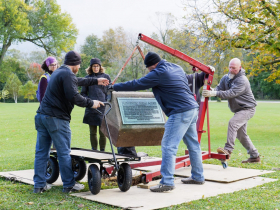
By Marcy Rockman, Lifting Rocks Climate and Heritage Consulting, for the SHA Climate Heritage Initiative
There’s been a change at Lake Park in Milwaukee, Wisconsin: a 114-year old historical marker set on top of the last burial mound in the area has been taken down. This is a good thing.
Several factors led to the removal. One was recognition that the placement of the sign on top of the mound was prompting people to walk up the mound to read it, which is disrespectful. As well, the title of the marker described the mound as “prehistoric.” As the National Association of Tribal Historic Preservation Officers (NATHPO) said in their sharing of this news on Facebook, “[i]f you ask just about any THPO, they’ll tell you there’s nothing their ancestors did that was ‘pre-historic,’ because their history reaches back millennia and lives on in them and their descendants.”
I’m sharing this here because it strikes me as such an important example of how our understanding of what history is and relationships with it are described and shared can and should change. Removal of an historic marker may sound like an isolated event. But concurrently, as the global climate meeting COP29 is nearing the end of its first week, the nation of Tuvalu is fighting for changes to the law of the sea so that it can retain perpetual connection to its area of the Pacific as seas rise and pioneering approaches to creating a “digital nation.” In both cases, Tuvalu is using new legal and technological tools to carry forward deep cultural connections.
As climate change and efforts to address it bring wide environmental, social, and economic changes, I see actions at both of these scales as critical. Honoring and repairing connections at the local scale indeed is essential to building a future that can broadly integrate care, justice, and connection to places we live.
Featured Link: https://urbanmilwaukee.com/2024/10/16/historical-marker-being-removed-from-milwaukees-last-indigenous-burial-mound/
For a listing of all blog posts in this series, visit our Climate Heritage Initiative page.
Photo credit:
Historical marker being removed from Lake Park in Milwaukee, WI (photo is not credited but, as published at the link above, appears to have been taken by Cari Taylor-Carlson).
COP29 and Building a Vision from Below “Z”
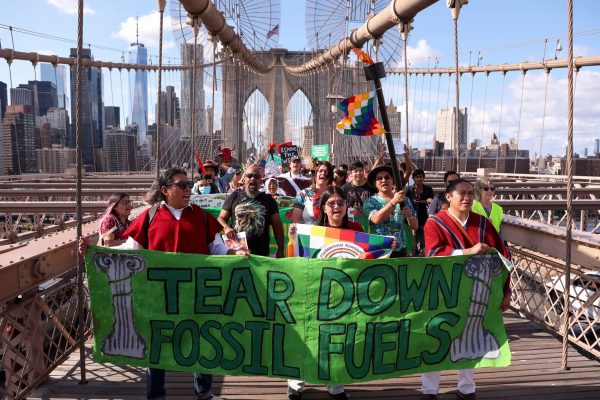
Climate activists marching on the Brooklyn Bridge in NYC during “Climate Week” in September 2024 (photo by Sarah Yenesel/EPA, published at featured link).
By Marcy Rockman, Lifting Rocks Climate and Heritage Consulting, for the SHA Climate Heritage Initiative
This week the 29th Conference of the Parties to the UN Framework Convention on Climate Change (COP29) begins in Azerbaijan. The COP29 Parties also are now one year into the first “stocktake” of their progress under the Paris Agreement, and Micro-Climate has reached its 10th week, so I’m going to do a small stocktake of purpose here.
In late September, former US Special Envoy for Climate Change John Kerry gave fossil fuel companies “a letter below Z” for their lack of progress in moving away from fossil fuels (featured link below). The period February 2023-January 2024 was the first to have an average temperature of more than 1.5℃. The outcome of the US election last week is highly likely to remove the US from the Paris Agreement again, slowing US and global progress toward its goals.
Recent reports are raising concerns about the apparent declining capacity of oceans and forests to absorb carbon (pre-print, Guardian-global, Guardian-Finland) and that reducing global temperatures by technical means if they exceed 1.5℃ will be more difficult than expected. In turn, the World Wildlife Fund (WWF) reports that world wildlife populations have declined 73% over the past half century.
In the face of all this, where does archaeology fit? WWF I think said it well, that
“(t)o maintain a living planet where people and nature thrive, we need action that meets the scale of the challenge…nothing less than a transformation of our food, energy and finance systems.”
This is the space in which archaeology and heritage should operate: building a vision that history is not about stasis but change, that culture and our senses of ourselves must be part of such transformations. The recent UN Pact for the Future states this should be done; it is up to us to do it.
Featured Link: https://www.theguardian.com/us-news/2024/sep/23/new-york-climate-week-al-gore-john-kerry-condemn-fossil-fuels
For a listing of all blog posts in this series, visit our Climate Heritage Initiative page.
Hurricane Impacts on North Carolina’s Coastal Plain Archaeological Sites
By Allyson Ropp, Historic Preservation Archaeological Specialist
As I write this, North Carolina faces a long road of recovery in its western reaches. Hurricane Helene sped through the west, dumping several feet of rain and generating a thousand-year flood event. This was a mere week after the southeastern portion of North Carolina also faced a massive flood event, caused by a random low-pressure system off the coast. These events wrecked immense damage to the people and towns within these regions, and many places are still recovering. These storms also separated people from place, damaging their connection to tangible and intangible resources. The questions now arise about what has happened to archaeological sites and how did these storms impact them.
These storms are not unknown to North Carolina. Since 2015, 28 tropical storms and hurricanes have come through the state, including Hurricanes Florence and Michael in 2018. Like Hurricane Helene, these storms caused immense loss of life and economic impacts. These storms also caused documented damage to cultural resources. These storms precipitated the release of funds from the National Park Service’s Emergency Supplemental Historic Preservation Fund (ESHPF). North Carolina received $9 million in funding to support internal and local community projects concerning historic property reconstruction and stabilization and archaeological site assessment and evaluation to impacts by hurricanes. The NC Office of State Archaeology (OSA) received about $1 million to complete two projects: one focused on the impact on historic cemeteries within coastal counties and one focused on the impacts on archaeological sites within intertidal shorelines.
To begin these projects, it was essential to identify sites across the coastal counties that would be impacted by hurricanes, as represented by storm surge, and additional environmental change, including sea level rise. While the ESHPF projects limited work to FEMA-eligible counties, we expanded this desk-review to encompass all 32 coastal counties. This desk-review calculated the number of sites across these counties, their identified cultural affiliation, site type, elevation, and distance to the nearest waterway. In total, 14,874 sites were identified across these counties, with an even spread between historic, prehistoric, and multicomponent sites (Figure 1).
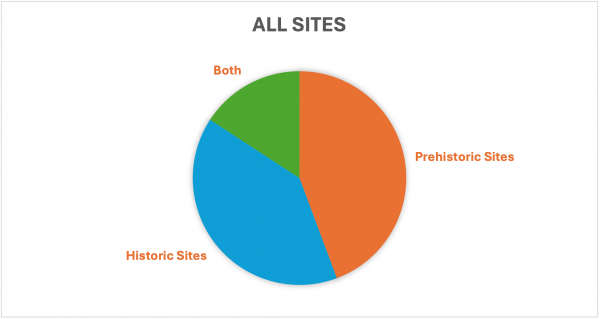
Figure 1. Breakdown of sites within the Coastal Plain (Photo courtesy of OSA 2024).
These sites were then compared to hurricane storm surge models over all five categories of storms. This showed that over a third of the sites in coastal counties would be impacted by Category 5 hurricane storm surge, and about a quarter for both Category 3 and Category 4 storms. At a county level, impacts varied depending on the proximity to the ocean and riverways (Figure 2). This includes almost complete inundation of Camden, Carteret, Currituck, Dare, Hyde, Pamlico, Pasquotank, Perquimans, Tyrrell, and Washington counties (Figure 3).

Figure 2. The number of sites per county impacted by storm surge from hurricanes. The inner ring represents sites impacted during Category 1 storms and the outer ring represents those impacted by Category 5 storms. The level of impact grows as the size of the storm grows (Photo courtesy of OSA 2024).
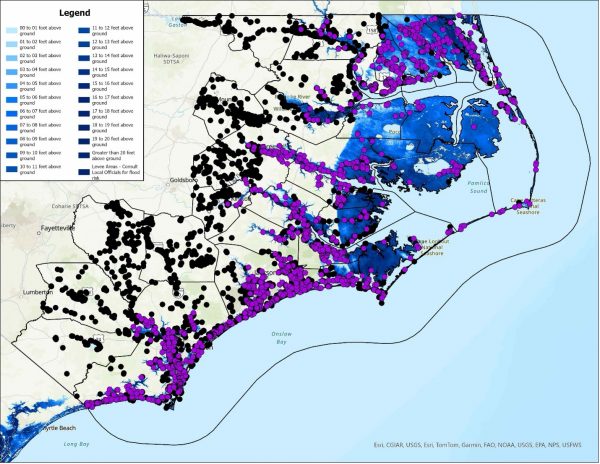
Figure 3. Archaeological sites impacted by storm surge of a Category 5 hurricane. Purple dots are those impacted by the storm surge, where the black are the remainder in the area not impacted by storm surge (Photo courtesy of OSA 2024).
Using this information and the ESHPF requirements, OSA set out to conduct ground-truthing to understand the impacts of hurricanes and other environmental changes to archaeological resources and cemeteries. Using a ranking system that accounted for environmental and historical priority, several areas were identified for the survey, including Hammocks Beach State Park in Onslow County, the Scuppernong River Section of Pettigrew State Park, and the Alligator River Game Lands in Tyrrell County (learn more about the process of prioritization and selection).
These areas underwent surveys from September to December 2023 by AECOM. After conducting miles of survey across all areas, AECOM presented the results to OSA. These results indicate difference in location in determining the level of impact from hurricanes and other environmental changes. Hammocks Beach State Park, a barrier island environment, is home to sites dating from the Woodland period through today, including several large indigenous occupation sites and a Civil War fort. Because of the barrier island environment, these sites are exposed to daily sediment movement and wind-driven fetch that dominant site formation process. The Alligator River Game Lands is a large tract of land in northern Tyrrell County along the Albemarle Sound and Alligator River. The identified sites represented colonial and early statehood occupation through maritime industries of the 20th century. Like Hammocks Beach, wind-driven waves drive processes along the Albemarle Sounds. However, sites along the Alligator River side are more protected from such wave action as they are tucked around a corner. Due to the swampy nature of the Scuppernong River, only one site was identified. As the site sits in 10 ft. of water and is tucked around a corner, it is unlikely that daily wave activity impacts the site.
During each category of storm, all three project areas are inundated, particularly along the shorelines where these sites were identified. This inundation from storm surge has immense impact on the stability of the sites. Many of the sites are buried and already eroding. The amount of force behind storm surge waters can further destabilize and erode these sites, causing undercutting and areas of collapse (Figure 4). Storm surge also destabilizes sediments surrounding built components of sites, leading to structural collapse. This effect was documented on several sites in the survey areas. Overall, these projects served two purposes. First, they began the process of conducting macro-scale analysis of hurricanes and sea level rise impacts on sites across the Coastal Plain. Second, they provided the opportunity to ground-truth these impacts to sites and discover new sites along the shorelines before their context is changed by hurricanes and large -scale environmental changes.
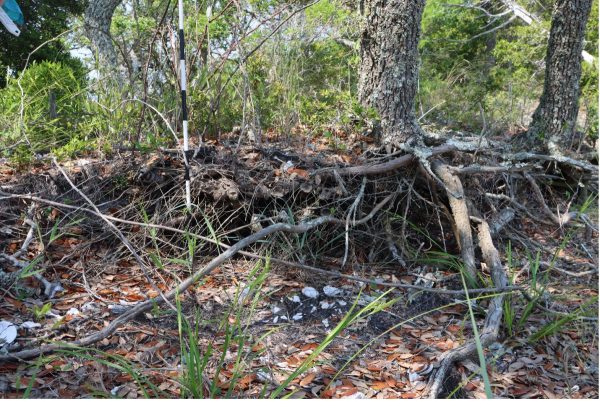
Figure 4. Shell midden undercutting and erosion in Hammocks Beach State Park (OSA 2024).
This material was produced with assistance from the Emergency Supplemental Historic Preservation Fund, administered by the National Park Service, Department of the Interior. Any opinions, findings, and conclusions or recommendations expressed in this material are those of the author(s) and do not necessarily reflect the views of the Department of the Interior.
Micro-Climate Blog: Building Care and Knowledge of Place through Community Archaeology
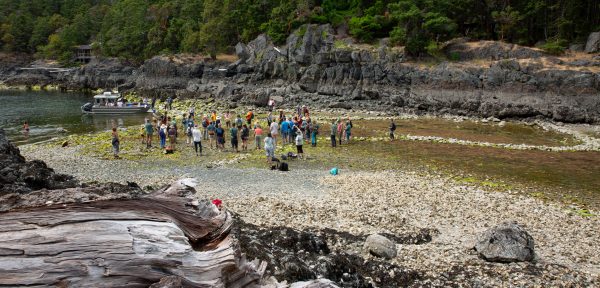
Community archaeology gathering on Xwe’etay, or Lasqueti Island, British Columbia (photo by Grant Callegari, published at link above)
By Marcy Rockman, Lifting Rocks Climate and Heritage Consulting, for the SHA Climate Heritage Initiative
On the coast of British Columbia north of Vancouver, a community archaeology project is bringing together First Nations members and non-Indigenous residents around a shared care for the history of the place in which they live.
As Tla’amin Elder Betty Wilson says, settling land claims and territorial recognition are important to First Nations, but projects such as the Xwe’etay/Lasqueti Archaeology Project (XLAP) are vital for helping others gain understanding of the land, who has lived there, and how. “‘It’s a part of your history,’ Wilson says. ‘It’s part of everybody’s history. It’s human history. And if you choose to live here then you need to know that history.’”
While many common conceptions of archaeology focus on finding objects and data about the past, community archaeology brings benefits to the present through the practice of archaeology and the ways in which the doing and sharing of this practice builds links between people and place. As described in this featured article (link below), community archaeology has been used as means of reconciliation in conflict zones, such as in Cyprus and in Ethiopia’s Tigray region.
Looking at current conditions and into the future, the changes of climate change are contributing to increases in disaster displacement, migration, economic transitions, more conflicts, and transformation of environments around those who stay in place. With these, there will be more need to connect and reconnect, learn and relearn, the places in which we live and to build and rebuild relationships with others who live there too. With a model such as XLAP, community archaeology can be a powerful tool to do these things.
Sources for finding community archaeology where you live include: Archaeology in the Community, Partners for Archaeological Site Stewardship, Florida Public Archaeology Network (Florida), Midden Minders (Maine), and Diving with a Purpose (underwater/coastal).
Featured Link: https://hakaimagazine.com/features/neighborhood-digs/
For a listing of all blog posts in this series, visit our Climate Heritage Initiative page.
Micro-Climate Blog: For the Well-Being of Future Generations

By Marcy Rockman, Lifting Rocks Climate and Heritage Consulting, for the SHA Climate Heritage Initiative
In 2015, the country of Wales passed its Well-Being of Future Generations Act with the purpose of improving the social, economic, environmental and cultural well-being of Wales.
The Act sets out seven goals:
- A prosperous Wales
- A resilient Wales
- A healthier Wales
- A more equal Wales
- A Wales of cohesive communities
- A Wales of vibrant culture and thriving Welsh language
- A globally responsible Wales
I will briefly jump up and down here, pointing out that culture is a clearly stated and fully equivalent part of this list, with the objective of helping to create and support “A society that promotes and protects culture, heritage and the Welsh language, and which encourages people to participate in the arts, and sports and recreation.”
The Act also charges each public sector and the bodies through which they work at local and national scales with working toward each of these goals. What this means is that heritage and culture bodies are not only responsible for heritage and culture, but also for linking their work with that of transportation, health, education, and others. In turn, these sectors are responsible for engaging and supporting heritage and culture in their work. It is an integrated vision that places care for heritage and culture as a key component of a sustainable future.
Today is Election Day in the US. If you have not yet voted, please do! And as writer Rebecca Solnit has eloquently said, “a vote isn’t a valentine, it is a chess move for the world you want to live in.” So I am sharing this as one possible direction in which it may be possible for us to go.
Featured Link: https://www.gov.wales/well-being-future-generations-act-essentials-html#
For a listing of all blog posts in this series, visit our Climate Heritage Initiative page.
Photo credit:
Graphic representation of the goals of the 2015 Well-Being of Future Generations Act (Wales) (published at Featured Link above).
Micro-Climate Blog: Ghosts and Glaciers
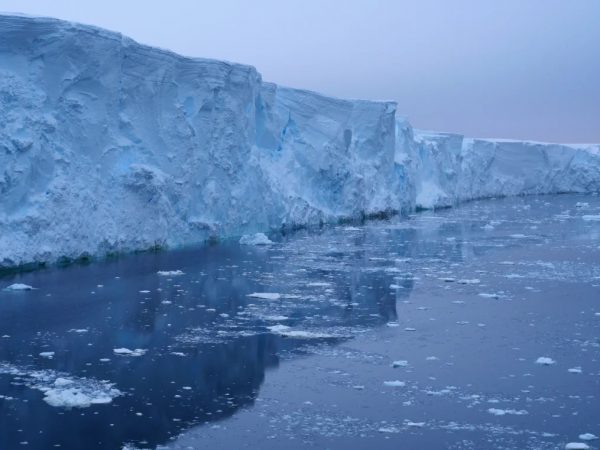
By Marcy Rockman, Lifting Rocks Climate and Heritage Consulting, for the SHA Climate Heritage Initiative
There are traditions that say Halloween is when the separation between worlds is at its thinnest. Now it is a time of ghosts and ghouls and scary things that can go bump in the night. Stories of melting of glaciers in West Antarctica feel appropriate for today on both accounts.
My feature story today is a summary of new research at Thwaites Glacier in Antarctica. The International Thwaites Glacier Collaboration (ITGC), a consortium of the US and UK with South Korea, Germany, and Sweden, has been studying Thwaites closely for six years. Their findings are showing not only that Thwaites is retreating and that retreat is accelerating, their work is showing how warmer ocean waters are being drawn under the glacier and the specific effects it is having on the ice. Currently, Thwaites is projected to collapse within 200 years. While recent modeling suggests that a domino-like cascade failure of ice cliffs is less likely than previously thought, this does not mean that the glacier is safe.
Thwaites Glacier itself holds enough water to raise global sea levels by 2 feet (0.6 m). Its collapse, however, could lead to further loss of ice sheets across Antarctica, generating 10 feet (3 m) of sea level rise.
This will be devastating in so many ways. Archaeologically speaking, the most wide-ranging study of sea level impacts on sites in the US is a 2017 study by David Anderson and co-authors. In this, a 1 m (3.2 feet) of sea level rise will result in loss of more than 13,000 known archaeological sites across the US southeastern states alone; higher sea levels and effects of movement of people and infrastructure inland will affect far more.
I think that’s plenty of scary to be getting on with.
Featured Link: https://www.cnn.com/2024/09/20/climate/doomsday-glacier-thwaites-melt-sea-level-rise/index.html
For a listing of all blog posts in this series, visit our Climate Heritage Initiative page.
Photo credit:
High cliffs of Thwaites Glacier, West Antarctica (photo taken by Rob Larter, British Antarctic Survey, published at the Featured Link).
Micro-Climate Blog: Water in the West
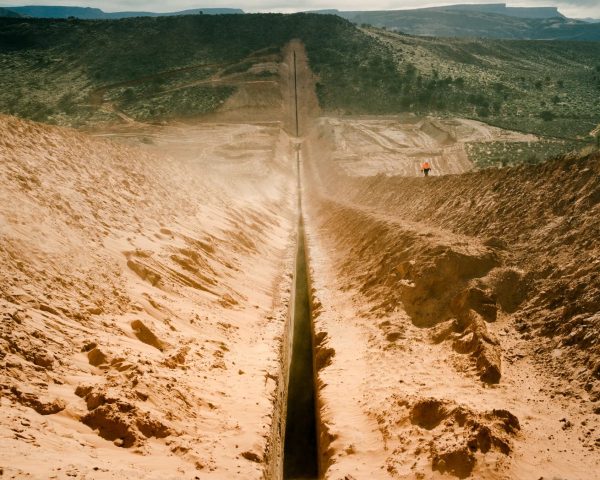
By Marcy Rockman, Lifting Rocks Climate and Heritage Consulting, for the SHA Climate Heritage Initiative
Water in the American West is a many-layered story. This piece from TIME contrasts and compares the water experiences of the Diné across the Navajo Reservation and communities of Washington County in southern Utah across issues of water rights, water realities, and values and perspectives that underlie them.
Archaeological connections to this story also have many layers. For one, people have lived with variable amounts of water across the region for millennia, and archaeology holds records of how and where they managed this. In their study of drought and migration across the Southwest, archaeologists Scott Ingram and Karen Schollmeyer shake up assumptions about vulnerability and adaptive capacity; archaeology here helping us to see what we thought we knew in a different light.
For two, this story is an explication of the diversity of values and perspectives for place and landscape that the practice of archaeology, done well, should always keep in mind. Water use in Utah seems hard to describe without reference to economic and population growth, even as conservation measures are showing effect; the Diné describe water as Life itself, as living.
For three, the 1922 Colorado River Compact, which assigned more water than is usually in the Colorado amongst its partner states, is an example of a legislative framework now being updated to better reflect the environments through which it flows. As work goes forward in effort to address other aspects of climate change, such as permitting for renewable energy, it is important for all of us to keep eyes on other legislation passed in the 20th century and ensure that the many layers and capacities of and care for archaeology and heritage are incorporated if and as these are updated.
Featured Link: https://time.com/7019660/colorado-river-water-drought-navajo-nation/
For a listing of all blog posts in this series, visit our Climate Heritage Initiative page.
Photo credit: View across the future Chief Toquer Dam, part of a series of ephemeral drainages that will form a new reservoir in southern Utah; photo by Elliott Ross (published in Time at the Featured Link) .




